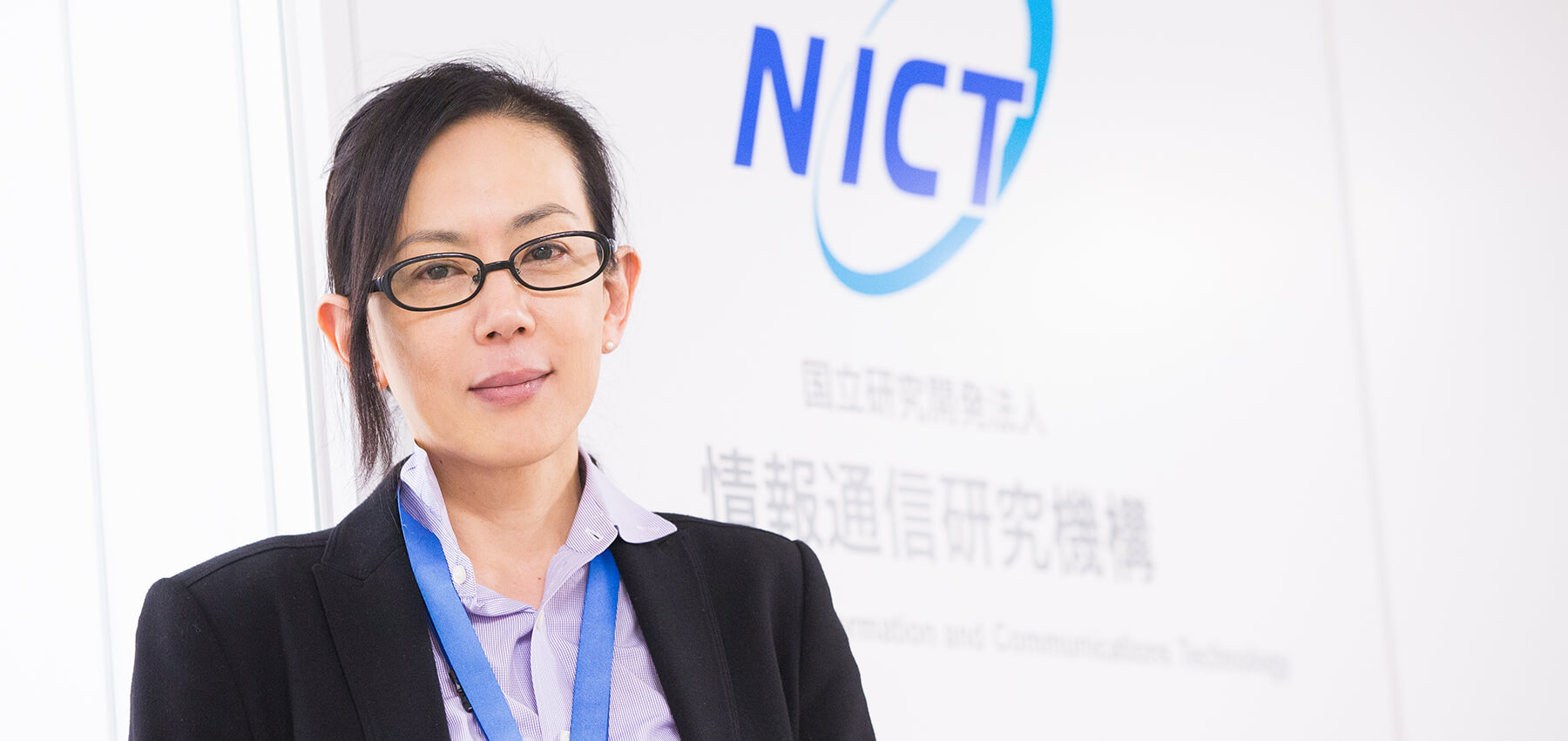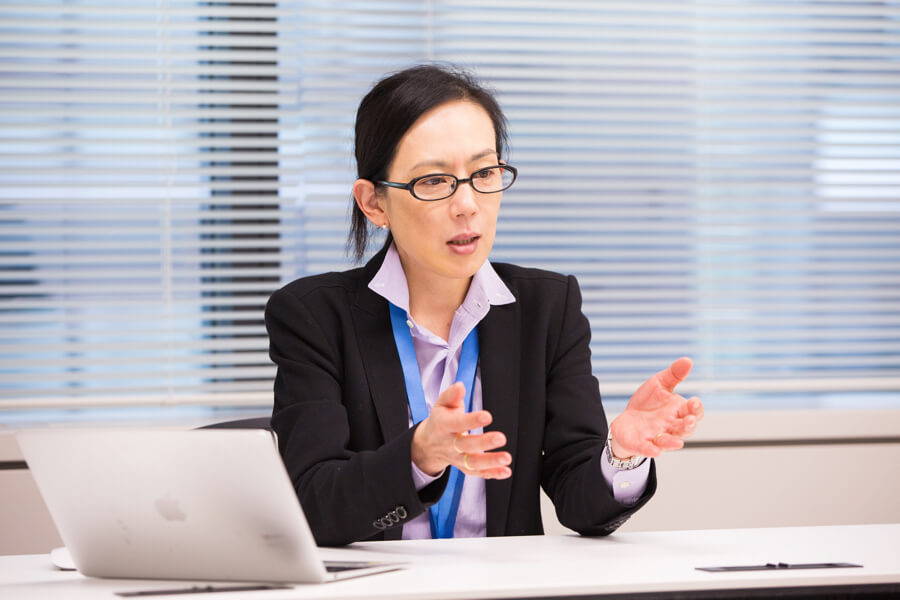
Vol. 8 / 2019.02.01
JUICE Player Interviews
is the history of science
Professor Kasai’s Current Research

——The 8th interview is with the representative researcher for Japan in the submillimeter wave instrument (SWI) development team in the JUICE-JAPAN project, Professor Yasuko Kasai of the Terahertz Technology Research Center at the National Institute of Information and Communications Technology (NICT).
Please can you tell us about your day-to-day research?
Dr. Kasai: We are developing observation equipment known as submillimeter wave instruments (SWI). The electromagnetic waves used for making observations are terahertz waves, which is a new frequency somewhere between light and radio waves that was relatively undeveloped until recently. The instruments that are being developed take advantage of the ability to miniaturize the sensors by raising the frequency to a higher level than that of radio waves.
About terahertz waves
——What exactly are the terahertz electromagnetic waves that are used in these observations?
Dr. Kasai: All objects, including you, emit electromagnetic waves according to the temperature of the object. The frequency of the electromagnetic waves that are emitted is determined by temperature. The temperature of the human body is around 36℃, which means that invisible electromagnetic waves (infrared) are emitted. The Sun has a temperature of about 6000K, which means that visible electromagnetic waves (visible light) are primarily emitted.
——If the radiation from the Sun is around 6000K, what effect does it have on humans?

Dr. Kasai: Visible electromagnetic waves are called “light.” Differences in the frequency of electromagnetic waves are perceived as differences in color by the human eye. Sunlight is thermal radiation from the Sun, and the 6000K surface temperature of the Sun produces a larger quantity of green-colored radiation. The human eye is able to see light in the frequencies that surround green. Green is in the very middle of the seven colors of the rainbow (red, orange, yellow, green, blue, indigo and violet). The reason for this is that, throughout our evolution, the Sun has been provided us with light, that is, light that contains a lot of green.
——Is this related to the reason why vegetation on Earth is green?
Dr. Kasai:
Yes. The benefits we receive from the Sun have caused this to happen. If the temperature of the Sun was slightly higher, we might be more sensitive to violet colors, and the color of vegetation might appear to be violet.
Going back to what we were talking about, on average, the temperature of the Earth is about 16℃, so the medium radiant intensity is an invisible area called “infrared.” Terahertz (around 300GHz-10THz) waves are emitted in the area between radio waves and infrared.
The history of human science and technology is partly the history of the use of electromagnetic waves. Mobile telephones also use radio waves, which is technology that was developed based on objects like cameras that could perceive visible light, that is, green light, and this later progressed to the use of radio waves. The use of electromagnetic waves with new frequencies enabled us to make things that had not been possible before.
Humankind is now able to use ultraviolet rays, infrared and radio waves, but terahertz is more difficult to use because the frequency is somewhere between radio waves and light. Therefore, this frequency was largely unexplored by mankind until about 10 years ago. However, there have been numerous achievements in this area, including “SMILES,” which is used in the International Space Station (ISS).
——Please can you tell us about the benefits of using terahertz waves, which were previously an obstacle for humankind.
Dr. Kasai:
In comparison to what has been used in prior investigations, terahertz waves have a higher frequency. Greater amounts of information can be sent in shorter periods of time using higher frequency radio waves. Even with mobile telephones, line speed is increasing because of the use of radio waves with higher frequencies.
Higher frequencies also have shorter wavelengths, so the advantage is that antennas and all other instruments can accordingly become smaller and lighter. For example, if the frequency was 600GHz rather than 60GHz, which is used at the moment, the size of the antenna could be reduced to 1/100th. Even just for this reason alone, we can say that higher frequencies are better.
Moreover, when measuring molecules in the atmosphere, the spectra of molecules can be increased using higher frequencies, which makes detection easier as it is proportional to the cube of the frequency. The benefits of this technology are numerous, but it has not yet been perfected, so we are working on this area in an effort to take it as far as it can go.
Difficulties of antenna design

——What kind of projects have you been involved in with regard to terahertz probes?
Dr. Kasai:
I have been involved in various projects, but, in terms of terahertz probes, I have worked on SMILES, SWI and the TEREX series.
Superconducting Submillimeter-Wave Limb-Emission Sounder (SMILES) is a joint development by NICT and the Japan Aerospace Exploration Agency (JAXA) (reference: NICT/JAXA), which is a project concerning the pioneering use of frequencies for NICT remote sensing observations. This was the first submillimeter-wave observation device in Japan.
I was the leader of SMILES on the NICT side. An ultra-high sensitivity sensor was installed on SMILES, which was used on the ISS until 2010. By researching the mechanisms of the collapse of the ozone layer in Earth’s atmosphere, we are able to estimate the destruction of the ozone in the densely-populated mid-latitude and equatorial regions, which helps to increase the accuracy of estimates regarding the time required for recovery following the destruction of the ozone layer.
In an effort to connect such experience with the development of a miniature submillimeter-wave observation device for planetary explorers, I started to participate in SWI development. Also, in terms of planetary explorers, there is a plan to investigate Mars with the launch in 2022 of Japan’s proprietary Mars micro-terahertz explorer TEREX-1, which is currently under development.
——What are the differences between the instruments equipped on SMILES and JUICE?
Dr. Kasai: First of all, the size is different. With SMILES, the weight was 500kg, as the priority was sensitivity. It was so big that a person could fit inside. At present, the weight for JUICE is about 13 kg, but ESA has asked us to make it even lighter. The plan for the Mars explorer is to make it less than 10kg.
——What role is Japan playing in the current SWI development for JUICE?
Dr. Kasai:
In the development of SWI, Japan is responsible for the development of the antenna and drive system architecture.
The development of the antenna is incredibly difficult. The antenna has an aperture of just under 30cm, which makes it heavier than normal, but we have to make it as light as possible because the probe will be taken all the way to Jupiter. On the other hand, the journey to Jupiter involves the technique of first going in the other direction toward Venus and then performing a swing-by to accelerate the spaceship using the gravitational force of Venus. After passing by Venus, which is the hottest planet in the Solar System, it will head toward Jupiter, which is the coldest planet, so the antenna will be challenged by expansion and contraction due to temperature changes. That is why it is important to make it as strong as possible.
Normally, though, lighter antennae tend to break more easily. There is a huge contradiction between the two demands, but our mission is to make an antenna that can withstand such extreme environments. Furthermore, because of the high frequency, the surface of the antenna must be polished with great precision, like a mirror, which is another difficulty.
Progress of the project

——In terms of the schedule, how has the project proceeded?
Dr. Kasai:
In 2018, the antenna and other parts for the launch were sent to Germany, where they were combined with parts from Sweden and France and sent off to ESA. ESA incorporated them into the satellite with the other sensors in preparation for the launch in 2022.
I strongly recommend looking at a document published by ESA called Red Book (English, PDF). It separately describes the major policies and observation devices of ESA. Each observation device is made through international cooperation, with some being managed by Japan. It covers all missions. This publication is from 2014, so there have been some changes over time, but I think everyone would enjoy reading it.
——That’s right. When you understand the processes, it’s more interesting.
Dr. Kasai:
After launching a rocket, we cannot repair the instruments in space, so the equipment undergoes test after test based on the prerequisite that failure is absolutely not an option. There are numerous stages involved before each and every one of the small parts can be handled as a “part for use in space.”
The first stage is a so-called Bread Board Model (BBM) where we think about all sorts of things and conduct various trials over and over again by adding to this part or taking from that part.
Next, the Engineering Model (EM) is the stage where we investigate the electric characteristics, for example.
After this, there is the Prototype Model (PM), the Pre-Flight Model (PFM) and the Flight Model (FM). Depending on the characteristics of the mission, a Qualification Model (QM) may be added between those stages, but this is the basic form of progression, with the accuracy being increased at each stage.
Furthermore, we also prepare something called a flight spare. With the idea in mind that an incident may occur during the flight, tests can be conducted on the flight spare while the engine is not operational in order to investigate the cause of the problem.
——The idea becomes clearer through repeated tests and solutions, then. It’s fascinating.
Targets of the JUICE Project
——Please can you tell us about the scientific targets of JUICE?

Dr. Kasai:
My answer will be a repetition of what the other professors have said, but JUICE is an explorer that will investigate habitability (the requirements for sustaining life) on the icy moons of Ganymede, Europa and Callisto. It will investigate the atmospheric make-up and the ground surface condition of each moon.
The atmospheres of the icy moons are formed by plumes (jets of seawater that escape into space) from the seas. Therefore, first, along with measuring “the physical components” in the atmosphere, we can make assumptions about “where those physical elements came from and where they go” by measuring isotopes including water vapor and oxygen. As for the ground surface, we will investigate the condition as to whether it is mushy, or whether the ice is melting or congealed. Furthermore, we will research the differences between each of the icy moons, Ganymede, Europa and Callisto. Finally, combining all of this, we will consider whether it is possible for life to exist on the icy moons.
JUICE is also investigating the Jupiter system as a typical model of a huge planetary system. It will provide an understanding of wind fields in Jupiter’s atmosphere, the atmosphere composition, and a three-dimensional structural understanding, and it will carry out remote sensing observations of Io.
The upper layers (thermosphere) and lower layers (troposphere) of Jupiter’s atmosphere have been thoroughly observed, but there is little information about the stratosphere in the middle, which has made it difficult to discuss Jupiter as a complete system. Now, by directly measuring the wind speed in Jupiter’s atmosphere and in the stratosphere, we will be able to understand the structure of activity in Jupiter’s atmosphere as a whole.
In order to conduct this research, we are comprehensively moving forward with the development and data analysis of a GCM (Global Circulation Model) for Jupiter’s stratosphere, the development of a model for the transmission of radiation in order to understand the condition of the atmosphere, and the development of observation equipment.
——So, it’s not just about developing instruments. It’s also closely related to science.
Dr. Kasai: Japan is making these arrangements. There are teams for science, data analysis and observation equipment development, and I am coordinating between all of these teams. The scientific side is being carried out with cooperation from every aspect of the JUICE project, while data analysis involves both domestic and international cooperation. I am concurrently working as a professor at the Tokyo Institute of Technology and the University of Tsukuba and students from those universities are involved in these teams.
——Please can you tell us about what led to your participation in JUICE?
Dr. Kasai:
The investigation of the use of terahertz waves is at the very forefront of research, and only a limited number of people have this technology, so researchers conduct lively exchanges. Until now, proposals have been produced jointly through cooperation among researchers around the world, including in the U.S., Germany, Sweden and Switzerland.
Before submitting a proposal for JUICE, I submitted a proposal regarding Mars to NASA in the U.S., but unfortunately it was not selected. I also submitted it to Japan. Then, I made a proposal to the EU regarding JUICE, which was selected.
——It seems like the same members from all over the world are involved in all of the projects.
Dr. Kasai: It is normal that the members are always the same, as there are very few researchers of terahertz waves, in particular, and the community is very small, so researchers who are making terahertz spectrometers are formed into teams around the world. However, there are different characteristics to each of the projects, so it is not possible to make sweeping generalizations.
——Have you noticed any differences between Japan and other countries? Is there an ideal organizational format that facilitates research?

Dr. Kasai:
One difference is that, in the U.S., NASA represents all of the space agencies in that country, but there is no such agency in Japan. JAXA is the largest agency in Japan, but there are also people who research space in NICT, the National Institute of Advanced Industrial Science and Technology and the Institute of Physical and Chemical Research. Even in the government, some are of the opinion that it would be a good idea to have a kind of Japanese NASA.
There may be a need for new structures that do not fall under the remit of JAXA due to the recent increase in active venture companies and the need for international coordination with regard to applications for the assignment of radio waves in near-Earth space, for example.
Background to taking an interest in space, and childhood years
——Please can you tell us how you first became interested in space?
Dr. Kasai: I did my PhD at the Tokyo Institute of Technology and then I observed space through microwaves at the Nobeyama Radio Observatory of the National Astronomical Observatory of Japan. I observed the spectra of molecules in dark nebulae and red giants and investigated their behavior. The environment in space is different from that of Earth (in fact, the environment in space may be more common), and there are molecules that do not exist on Earth. We have detected long chains of carbon molecules.
——Going back a bit further to your childhood, can you tell us anything about your private life?

Dr. Kasai: I’m often asked about this, but it’s difficult to recall anything as I am enjoying the present time so much that I don’t really remember my childhood. I know that I loved cucumbers when I was a kid [laughs]. Also, while looking at globes, I used to notice how the shape of the continents could join together, and I thought, “Long ago, the Earth was small, and maybe the land broke apart when it got bigger.”
——I see! Apart from cucumbers [laughs], do you have a message for the readers about the topic of the “future” as far as you view it?
Message to readers
Dr. Kasai:
When Columbus went in search of the New World, he surely had never considered that we would be able to go anywhere on Earth using airplanes like we do today. However, that was about 500 years ago. Now, the same thing is happening with space; we are reaching a time when human activity will extend to near-Earth space, which includes Earth, the Moon and Mars. Just as Columbus set out on the Atlantic Ocean, the period in which we set out from Earth is just ahead of us.
We are searching for water on Mars, for example, so that we can be self-sufficient in space in terms of energy. If there is water, we can make oxygen and hydrogen, which are sources of energy. The time is coming when we will be able to make unmanned, autonomous factories on the Moon, grow vegetation in caves, and set out for Mars from the Moon.
When the children who are now elementary school students become adults, such things may be normal. Please, set out for space and the future, remembering that there are worlds that we have not yet discovered.
Interviewed by Nishikawa, Nyan & Co.

